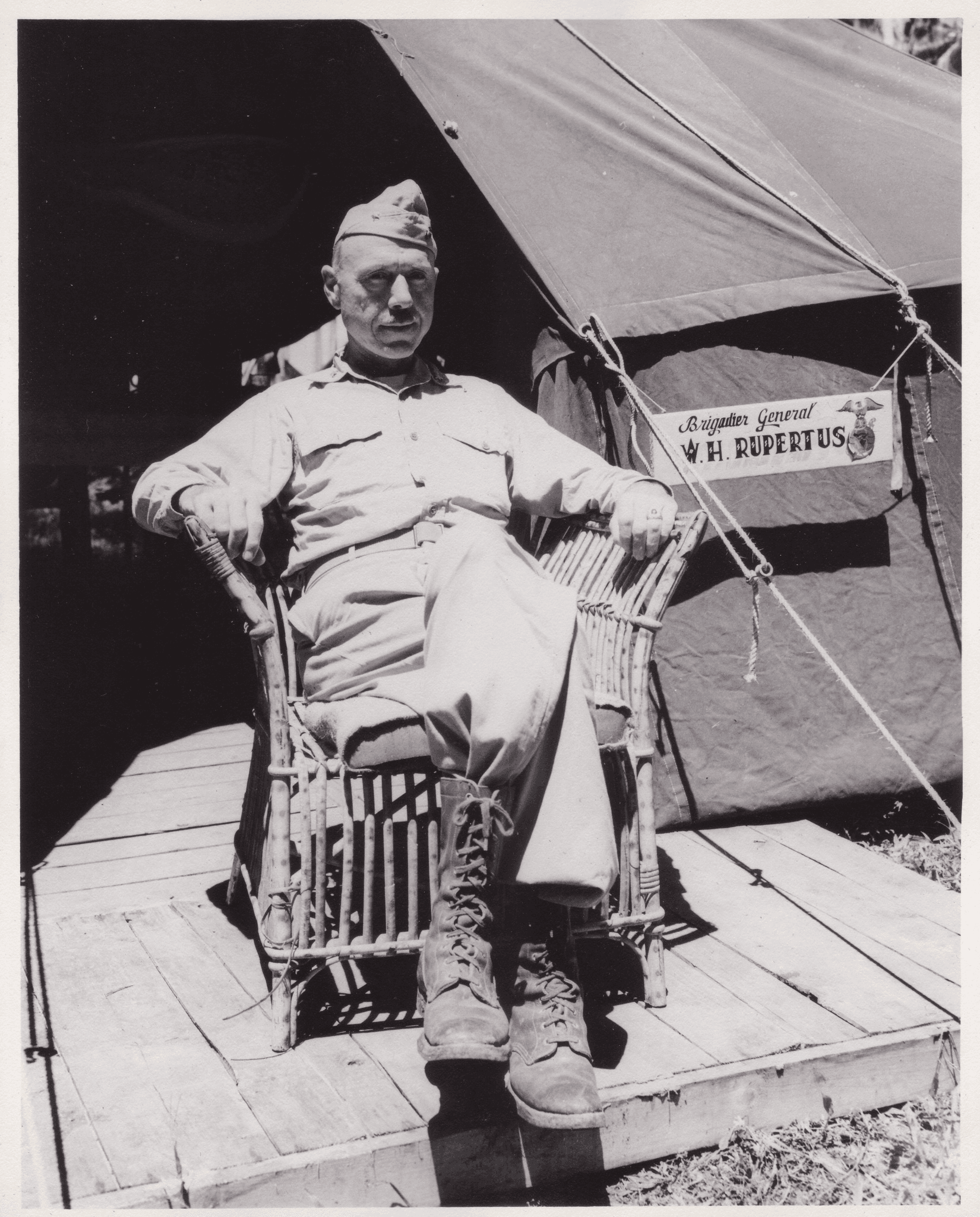
Marine Maj. Gen. William H. Rupertus is our grandfather who has always been a legend in the family. As are the many members of our family members of the greatest generations.
He is extra special because he was our beloved dad Patrick Hill Rupertus’s father.

Our father, Patrick Hill Rupertus (1939-1991), graduated from the United States Naval Academy in 1962. He became a Marine aviator, flew the A-4 Skyhawk, and did two tours of Vietnam. In 1991, he died as a result of Agent Orange related cancer.
General Rupertus, has father, was a commanding officer in Haiti, China (twice) and in WWII Pacific he commanded the First Marine Division from Tulagi and Guadalcanal to Peleliu. He authored the Riflemans Creed (aka My Rifle, The Creed of a United States Marine), and post humously was the namesake for the USS Rupertus DD851.
Why did I want to write this book?
The purpose of this book had three main objectives:
- To break the silence, set the record straight, and share what we know and learned about our grandfather, a US National Archives Person of Exceptional Performance and prominent United States Marine Corps Major General.
- To pull together disperse family military memorabilia with intelligence from the archives to contribute to the database of knowledge for our family, the Marine Corps, and US history.
- To show the perseverance, patience, and extremes our military and civilians experienced before and during WWII, and highlight key military and civilian leaders our grandfather knew whom we know little of today.
Why else? I began this book for my Marine family and for history. My sisters and I wanted to make sense of what has been left behind in our trunks and the archives, in comparison to what we read about our grandfather, and the war in the Pacific.
And, we are daughters and granddaughters of United States Marines. And great, great granddaughters of the Civil war and great, great great, great, great granddaughters of the Revolutionary War.
Finally, the Rifle Creed General Rupertus wrote is powerful and the background of its author should be known.
The Rifleman’s Creed was written by our grandfather after the Japanese bombed Pearl Harbor in 1941, while he was commanding officer of the Marine Barracks Naval Air Station San Diego, and thousands of young men joined the Marines.
It was published in the Marine Corps San Diego Chevron, on March 14, 1942, right as Rupertus left to join General Vandegrift and the 1st Marine Division in New River, NC.
The honing of the man, the patience, bravery, dedication, guts, sacrifice and laser focus needed to succeed.
He wrote this creed to get the Marines hearts and minds around their weapon. To ensure young Marines understood the power of their rifles as much as they understood themselves, their mission, and that they, and we, are part of one.
My Rifle The Creed of a United States Marine
This is my rifle.
There are many like it, but this one is mine.
My rifle is my best friend.
It is my life.
I must master it as I must master my life.
Without me, my rifle is useless. Without my rifle, I am useless.
I must fire my rifle true.
I must shoot straighter than my enemy who is trying to kill me. I must shoot him before he shoots me. I will...
My rifle and I know that what counts in war is not the rounds we fire, the noise of our burst, nor the smoke we make. We know that it is the hits that count. We will hit…
My rifle is human, even as I, because it is my life.
Thus, I will learn it as a brother.
I will learn its weaknesses, its strength, its parts, its accessories, its sights and its barrel. I will keep my rifle clean and ready, even as I am clean and ready. We will become part of each other.
We will…
Before God, I swear this creed. My rifle and I are the defenders of my country. We are the masters of our enemy.We are the saviors of my life.
So be it, until victory is America’s and there is no enemy, but peace!
What is this book Old Breed General about?
It is a literary historical non fiction on the life of Major General Rupertus, and his experience with the Marines, military and our allies in WWII Pacific. The reader will be transported back to August, 1942 and dropped on a ship with Gen. Rupertus in the Pacific as the Allied fleet races to meet the Japanese.
Why is this book relevant now?
Russias unprovoked attack on Ukraine for land and resources is similar to Japan’s conquest for land and resources in China and the Pacific during the 1930s to WWII.
Things in the Pacific and South China Sea are hot -as is the advance by China on some of the same islands Rupertus, the Americans, Australians, New Zealanders and Japanese fought on.
Rupertus’s first family died of a Scarlet Fever pandemic in 1929/1930 while they were stationed in Peking, China. His wife was 38, son 14, daughter 4. Ouch. They are buried with him and our parents at Arlington National Cemetery.
We had the Covid pandemic in our lives for over two years where people lost family and loved ones. How did he pull through? How can we pull through?
It’s a good time to look at the past for lessons learned- and consider the art of surprise.
What are the top 4 things to know about Rupertus?
1. Rupertus and the 1st Marine Division won the first ground battle in WWII Pacific at Tulagi.
2. Rupertus was the longest commanding general of the 1st Marine Division in the Pacific.
3. He wrote the famous Rifle Creed
4. He had a US naval destroyer named after him, the USS Rupertus, dd851.
Yet. His story has never been told until now.
What about his roots? Where did he go to school?
Saxon blood. Germany to Washington, DC. Strong work ethic.
We can trace Major General William Rupertus’ paternal side back over 240 years to Kirchheim, Germany. His great grandfather was Johannes Rupertus, a master shoemaker who lived and worked in the riverside town of Kirchheim in Baden-Württemberg, Germany.
He was married to Magdalena Siefert (From Hesseldorf in Hessen, Germany), and together they had two sons, Gottlieb and Henry. Gottlieb (our great, great grandfather) was named for his Godfather, Gottlieb Lange, the uber-Burgermeister of Kirchheim at the time and dear friend of Johannes.
Rupertus’s grandparents Gottlieb and Maria Rupertus were the patriarch and matriarch of the Rupertus family. They had emigrated from Germany and arrived in the United States in the 1850s. They lived in Washington, DC and had four boys and one girl: Henry (born 1856), William Henry (born 1858), Charles (born 1860), John Frederick (born 1870) and finally Mary “Maime” arrived in 1874.
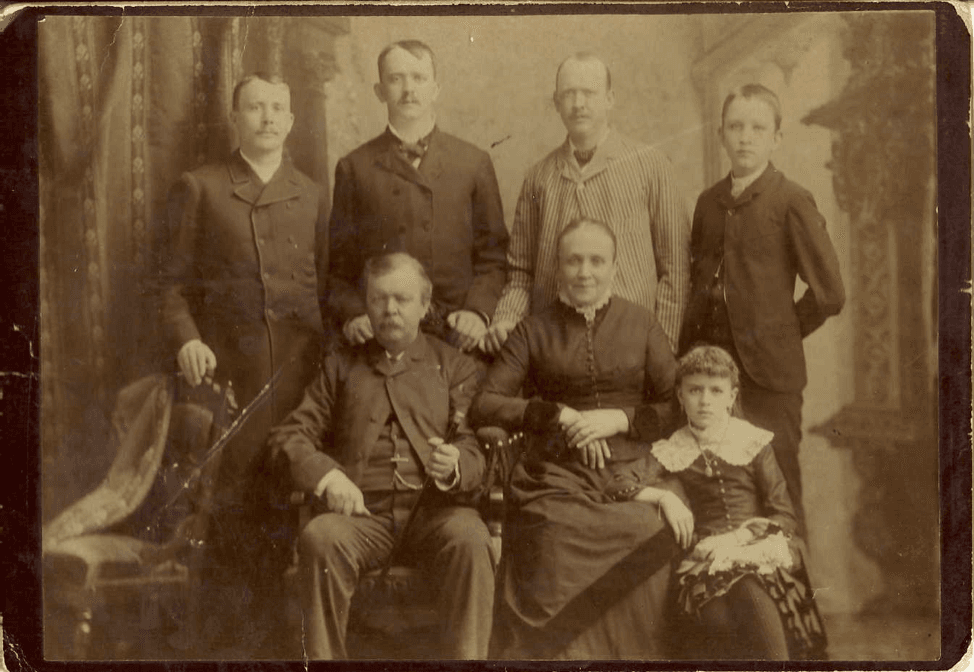
Gottlieb enlisted as a sergeant in Captain Ernest Loeffler’s Company A of Washingtons 8th Battalion of the District of Columbia and briefly served in the Civil War.
He later owned a luxury goods store that carried embroidery material, Berlin Zephyr Worsted will, Genilles Head Dresses, fans, sofa cushions, slippers, floss and silk tapestry, crochet cotton, canvas, beads and sultry items from Paris. They were active in the German American community and church.
Rupertus’s father, Charles Rupertus, owned a restaurant and cigar bar in Washington, DC. His mother, Augustina Meile Rupertus, was from Baden Baden, Germany. In Washington, DC she was also active in the community, church, and was an executive director of the German Orphanage. Augustina had three children in four years. Mary Louisa (born 1885), Frederich George (born 1887) and William Henry “Bill” (1889), our grandfather.
Rupertus’s parents Charles and Augustina, along with many family and friends, attended the Concordia German Evangelical Church in Northwest Washington (Circa 1833). Many of these German Americans, including those from our family, are now buried in the old tree lined Prospect Hill Cemetery, originally owned by the Church.
Last I checked, the church is still there and does a service in German one a month. Since 1833 the church has been located in the Foggy Bottom section of Washington, DC, on the corner of G and 20th streets.

Rupertus attended the Emerson Academy and McKinley Technical High School in Washington, DC as a cadet.
Upon graduating as a cadet in 1906, Rupertus enlisted with the Washington DC National Guard also known then as the D.C. Militia. He served for over three years and honed his skills at the naval gunnery.
On May 5, 1910, at age 21, Rupertus accepted an appointment to the United States Revenue Cutters School.
What was The Revenue Cutters Service School?
The Revenue Cutters Service was an armed maritime customs enforcement agency initially established in 1790 by Alexander Hamilton, one of America’s founding fathers and the first treasury secretary of the United States. The Revenue Cutters Service eventually evolved into the US Coast Guard.
During his time at the school, Rupertus had the opportunity to embark on summer cruises around the world, which he greatly enjoyed. He excelled in his studies and graduated second in his class of fourteen on May 13, 1913.
However, after graduation, he underwent a medical examination and was diagnosed with Bright’s Disease. The doctors at the Revenue Cutters Academy informed him that he had only five years to live.
Shocked by the diagnosis, Rupertus made the difficult decision to resign from the cutter service on June 18, 1913.
According to an old article my sister Kimberly found, a revenue cutter official said, his case was “A particularly hard one for them and the service. By the retirement of Cadet Rupertus, they lost the service of a promising young man, who would have made a valuable officer.”
The United States Marine Corps
Rupertus was not one to sit in idle. He turned to the even older amphibious corps, the United States Marine Corps, first formed as the Continental Marines at Tun Tavern in Philadelphia on November 10, 1775, by a committee of the Continental Congress.
Several letters arrived on the desk at the Marine Headquarters, which contained reliable testimonials on Rupertus’s character and work ethic.
In that summer of 1913, Rupertus took the exam, sat before the Marine Examining board in July, had a personal interview with Commandant Biddle, and was approved to move forward in the candidate process.
His persistence and reputation built over his first 24 years paid off.
As many Marines said, this part of the interview process was clearly to check the men out to make sure that they “looked the part” of a Marine officer.
The tour of duty and chess game begins.
The Marine Corps Rifle Team, Norfolk, Va, New York, USS Florida, Haiti, OTS, Peking China, Washington DC, Sunnyvale, CA, Guantanamo Bay, Cuba, Marine Barracks, DC, Shanghai, China, San Diego, CA, New River, NC, New Zealand, Tulagi, Guadalcanal, Australia, Cape Gloucester, Pavuvu, Washington, Peleliu, Quantico. Arlington.
Awards and Honors
Haitian Campaign Medal 1921 Haitian Distinguished Service Medal
Marine Corps Expeditionary Medal (I Bronze Star)
China Service Medal
World War 1 Victory Medal with Grand Fleet Clasp
Marine Corps Expeditionary Medal (1 Star)
Navy Cross Tulagi, Solomon Islands
Navy Distinguished Service Medal, l Peleliu
Army Distinguished Service Medal, Cape Gloucester, New Britain American Defense Medal
American Campaign Medal
The Asiatic–Pacific Campaign Medal (4 Bronze Stars)
The World War II Victory Medal
The Presidential Unit Citation (1 Blue Stars)
We still have all of his medals, the folded American flag that was over his coffin and given to our grandmother Sleepy when he was buried with full military honors at Arlington Cemetery. I have his sword, guns, silver polo cup awards from China, his leather horse whip from his polo playing days, Marine Corps lighter (that I was told should play the Marine Hymn). I have his starched khaki uniform, dress blues, cap with the 1st Marine Division patch, pistols, knifes, and his extremely worn slim brown leather aviator jacket and lightweight cotton jacket. My sisters and I still use the Nichols rugs, china, old chests and art he bought while stationed in China.
We used to have his original portrait but that was stolen (?!). So, our mom Gail had a copy painted from a photo. It’s good- I need a better picture of this portait.

One medal he received has quite a story.
It’s a small commemorative medal. What did it mean?
Was God throwing the Marines a football in the desert? And cows flew?
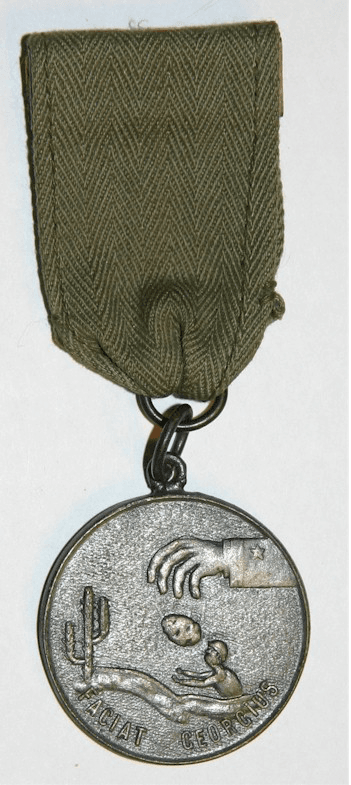
I found out this Faciat Georgius medal was for his service on Guadalcanal in the Pacific during World War II when the Navy “left” the Marines early in the fight due to a suprise Japanese naval attack. It is known in the Marine Corps as the unofficial George medal, as in the popular saying back then, “Let George (aka 1st MARDIV) do it.”
The front of the medal shows a Marine about to catch one hot potato their sorry Navy colleagues dropped upon them on August 9, 1942. This was the day, when being suddenly outgunned by the Japanese in the terrible Battle of Savo Island, the Navy quickly withdrew from their station, leaving the Marines on Guadalcanal for weeks with only half the supplies and ammunition they needed.
The back of the medal shows, ahem, the shit hitting the fan and:
In Fond Remembrance of
The Happy Days Spent
From Aug. 7th 1942
To Jan. 5th 1943
U.S.M.C.
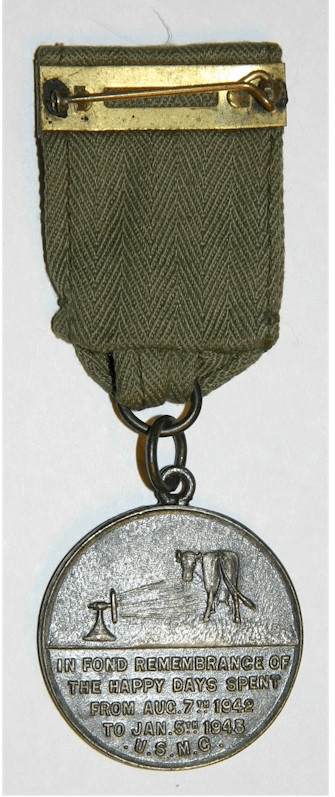
You see, it’s such fun and important history, I can’t do it justice in a long blog post- so I’ll stop here.
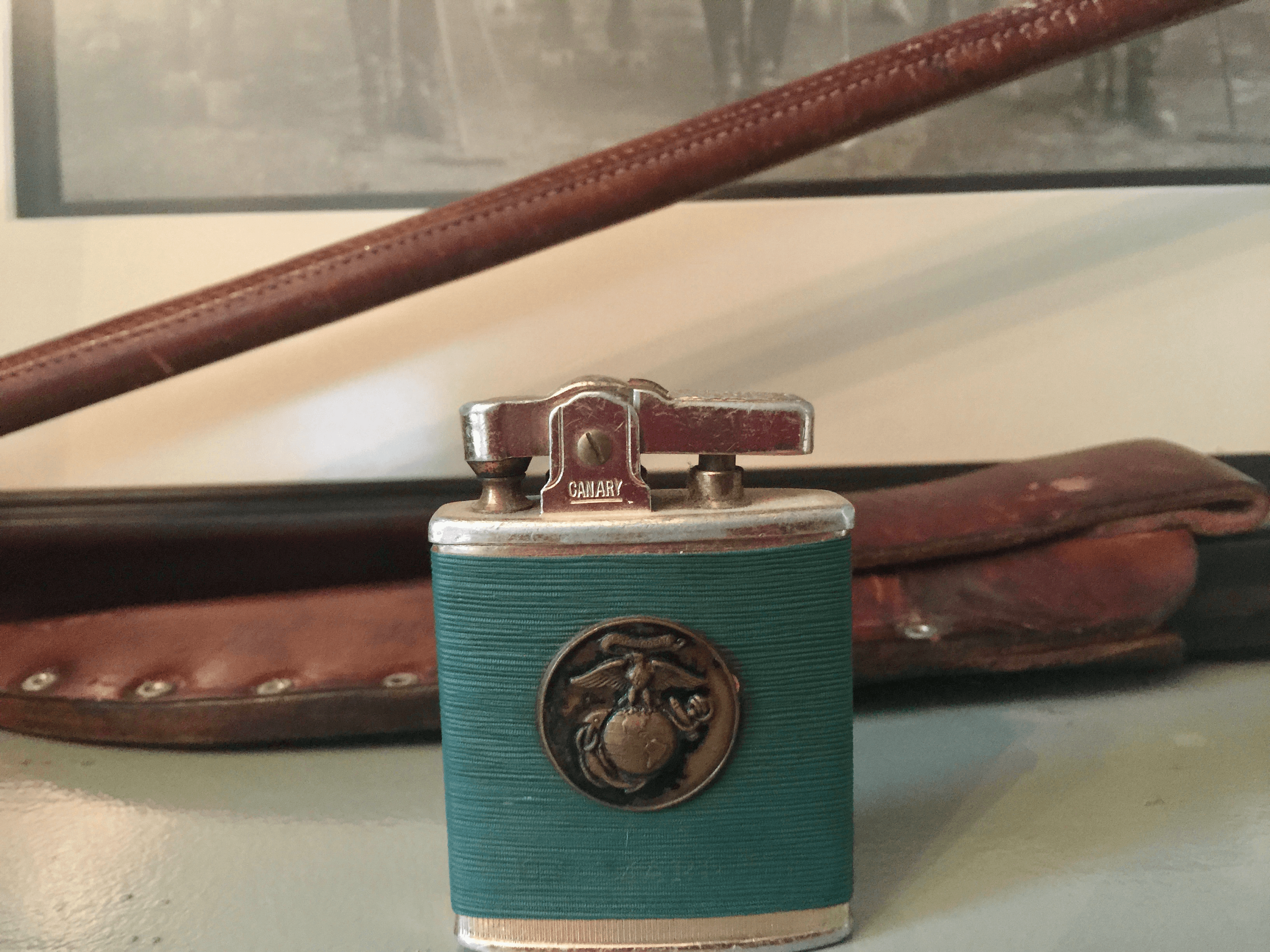
You’ll have to read the book for more intel.
Semper Fi.

12 Responses
Incredible Story !! Can’t wait to read the book cover to cover. Well done Amy and thank you for sharing this history of a great American ~
I had the honor of serving aboard USS Rupertus DD-851 from August 1966 to January 30, 1968.
Was aboard for gunfire support in Vietnam and was there for tge famous USS Forrestal incident, Juky 29, 1967.
I was an Electronic technician. All radio transmitters and receivers were my responsibility to keep in working condition.
I feel nostalgic when I, see photos of her.
Wonderful. Can’t wait to read!
Epic indeed! So much rich history and many timeless lessons I can’t wait to learn. Your family should be very proud of your years of hard work!!!
Amy you and I have a lot in common. Your dad served and so did mine. My dad was in WWII in the ETO and came in almost two month after Normandy. He was drafted out of NC A&T State College(now NCA&T State University where he was a Mechanical Engineering Major). He participated in the Battle of the Bulge and came back home safely. Mom and dad married in the 1950s andhad us close to the 1960s. Mom was a teacher and a history major and so was I. I am working on a book aboout thei lives and will read yours soon. Also my sister -in-law’s dad was a Marine Officer who became a professor of Chemistry. Finally, I have a co noncom who was born in Salisbury, NC. I am looking forward to your lecture online at the National WWII Museum next week. Take care.
Dear Ms. Peacock:
I am completing a book on Navy Cross recipients and would like to know if you have his official Navy Cross citation. I downloaded his military file from the NPRC website which consists of 980 pages, but the citation is not in his file. There is one on the Military Times Hall of Valor website, but many of the citations listed on the website contain inaccuracies; therefore, I only rely on information from a military file. If you have his citation, I would greatly appreciate receiving a copy.
I look forward to reading your book. Your grandfather was married to my mother’s aunt – Marguerite Gorman, who as you of course know died in China along with both of their children. I have a copy of the telegram that her father received to tell him that their bodies were being sent back to DC and he was the one who met and received them. It’s profoundly sad. Her sister, Beatrice Gorman Mulligan, was my grandmother. I have long wondered why General Rupertus left the Coast Guard (as I know it – I grew up in the USCG because my father served for 35 years, retiring as a rear admiral). Thank you for that information. Rupertus and my mother’s uncle, Frank Gorman, were best friends and I believe that they graduated 1st and 2nd in their class at the Revenue Cutter School (USCGA). Uncle Frank went on to become a rear admiral in the Coast Guard. I don’t know for certain, but it seems likely that your grandmother and Marguerite met through Frank, seeing as how Frank and Marguerite were siblings and Frank and your father the best of friends. I also see from your site that I’ve had your grandfather’s parental information wrong in my Ancestry tree for years! I’m off to correct that now.
Hi again – one thing I forgot to mention above is that your grandfather had a big impact on my mother’s family. Her younger brother, William Rupertus Mulligan was named for your grandfather and his son is William Rupertus Mulligan, Jr. So the friendships must have been really tight. I also have a typo in what I wrote above – I typed grandmother when I meant to type grandfather – that your grandfather and Marguerite met through Uncle Frank.